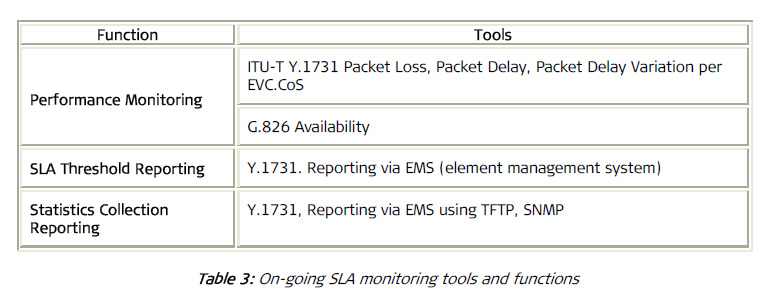




On-going Service Control and Monitoring for Carrier Ethernet
On-going Service Control and Monitoring for Carrier Ethernet
KPI measurements are also performed on an on-going basis, to monitor network health and ensure that QoS is maintained per class of service and in accordance with the contracted SLA. Continuous
monitoring is required to detect service degradation and network congestion, prompting relevant alerts and advising when an increase in bandwidth is required. When service outages or connectivity
faults are identified, Trouble Tickets are initiated and appropriate remedial actions taken.
The collected data is integrated with billing and other back office systems, while reports of network
and service conditions may be available to the enterprise periodically and on-demand. OAM tests are performed at a frequency that balances between the need to quickly detect and repair problems, and the service providerís desire to limit the toll such tests take on network and bandwidth resources.The table below provides a summary of on-going monitoring tools and functions:

Performance monitoring of Carrier Ethernet
Frame Delay (latency): Tests a frameís travel time across the network end-to-end, i.e., between ingress UNI-N (network side of the UNI) and egress UNI-N. Frame size, transport media, congestion,
and the network elements themselves are all contributing factors to network latency. The test measures the elapsed time between the start of transmission of the first bit of a time-stamped delay measurement (DM) frame at a source MEP (e.g. ETX-A at headquarters), and the arrival of the
last bit of that same frame at the destination (e.g. RICi at branch A). The receiving MEP then compares the time-stamp to its own reference clock and calculates end-to-end transmission delay. Unidirectional delay measurements require that both MEPs are synchronized. Alternatively, frame
delay can be measured on a round-trip basis, by analyzing the difference between the transmit
time stamp in a DM message and the receive time stamp of the DM reply that was returned to the originating
MEP.
Frame Delay Variation (jitter): Measures the variation in frame delay by comparing the time interval between consecutive frames belonging to the same CoS flow at the ingress UNI to the delay in
arrival of the same frames at the egress UNI. In round-trip delay variation calculations, FDV is defined as the difference between two consecutive frame delay measurements at the same MEP.
Frame Loss: Measures the rate of frames that are being dropped during transmission. Uni-directional (dual-ended) frame loss ratio can be determined using live traffic, by analyzing the
counters for sent and received frames at the service end points and measuring the number of
lost/discarded frames out of all frames that should have been delivered within a specified time interval. Bi-directional (single-ended) frame loss ratio measurements refer only to the initiating device and involve the exchange of loss measurement (LM) messages and LM replies.
Availability: Calculates service uptime based on the number of seconds that the network or service were unavailable to the enterprise. For example, with an SLA guarantee of Four Nines (99.99%)
availability, the enterprise should not experience service down-time for more than 4 minutes and
19 seconds throughout a 30-day month [60 minutes x 24 hours x 30 days x (1-0.9999) unavailability threshold], excluding
scheduled maintenance windows.
The demarcation devices determine the service availability rate by applying a G.826-based calculation on frame loss ratio
(FLR) levels or by leveraging on-going CC measurements. The demarcation devices record minimum, maximum and average values for delay and delay
variation, together with the rate of frame loss and the number of seconds during which the service
was unavailable Ė all for a pre-set interval. Performance statistics are collected and sent periodically
to the service providerís network management system (NMS) to deliver an up-to-date account of service quality, as well as an historical view of network and service behavior, without over-taxing the network with excessive management traffic. This enables both provider and customer to easily
evaluate actual performance over time and compare it to SLA guarantees.
SLA Threshold Reporting
Advanced demarcation devices support user-defined threshold configuration, whereby users can
define thresholds according to SLA objectives and receive exception traps and alarms. Device- and
event-based threshold configuration enables proactive notification of SLA violations at the device
level without the need to rely on external performance monitoring software.
Return to Carrier Ethernet with RAD products